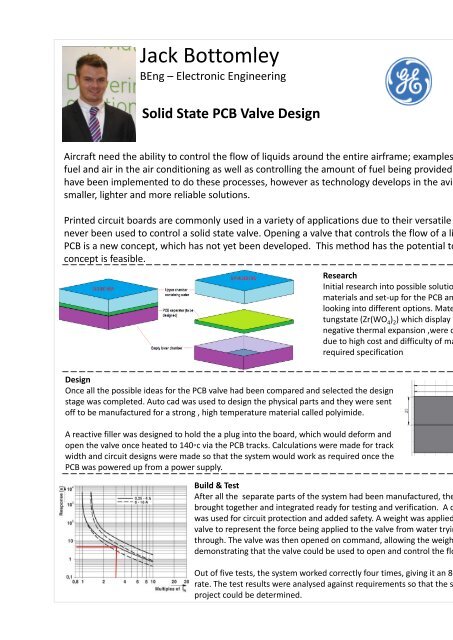UWE Bristol Engineering showcase 2015
Create successful ePaper yourself
Turn your PDF publications into a flip-book with our unique Google optimized e-Paper software.
Jack Bottomley<br />
BEng – Electronic <strong>Engineering</strong><br />
Project Supervisor<br />
Nigel Gunton<br />
Solid State PCB Valve Design<br />
Aircraft need the ability to control the flow of liquids around the entire airframe; examples include re-directing or stopping the flow of<br />
fuel and air in the air conditioning as well as controlling the amount of fuel being provided to the engines. Until now, mechanical valves<br />
have been implemented to do these processes, however as technology develops in the aviation industry, there is becoming a need for<br />
smaller, lighter and more reliable solutions.<br />
Printed circuit boards are commonly used in a variety of applications due to their versatile functionality; however until now they have<br />
never been used to control a solid state valve. Opening a valve that controls the flow of a liquid between two chambers, using only a<br />
PCB is a new concept, which has not yet been developed. This method has the potential to replace the mechanical alternative if the<br />
concept is feasible.<br />
Design<br />
Once all the possible ideas for the PCB valve had been compared and selected the design<br />
stage was completed. Auto cad was used to design the physical parts and they were sent<br />
off to be manufactured for a strong , high temperature material called polyimide.<br />
A reactive filler was designed to hold the a plug into the board, which would deform and<br />
open the valve once heated to 140◦c via the PCB tracks. Calculations were made for track<br />
width and circuit designs were made so that the system would work as required once the<br />
PCB was powered up from a power supply.<br />
Research<br />
Initial research into possible solutions was completed. The<br />
materials and set-up for the PCB and valve were chosen after<br />
looking into different options. Materials such as Zirconium<br />
tungstate (Zr(WO 4 ) 2 ) which display characteristics of<br />
negative thermal expansion ,were considered but rejected<br />
due to high cost and difficulty of manufacturing them to<br />
required specification<br />
Build & Test<br />
After all the separate parts of the system had been manufactured, they could be<br />
brought together and integrated ready for testing and verification. A circuit breaker<br />
was used for circuit protection and added safety. A weight was applied to the PCB<br />
valve to represent the force being applied to the valve from water trying to pass<br />
through. The valve was then opened on command, allowing the weight to fall,<br />
demonstrating that the valve could be used to open and control the flow of water.<br />
Project summary<br />
The project was to research then design and<br />
build a prototype PCB board that has the<br />
ability to open a valve ,allowing the flow of a<br />
liquid to be controlled.<br />
This project was initiated so that a modern<br />
solution could be developed with a view of<br />
replacing a mechanical valve that is currently<br />
used for this application.<br />
Project Objectives<br />
The objective of this project, was to prove a<br />
conceptual idea that a valve can be controlled<br />
by a PCB using minimal components. The aim<br />
was to design and build a prototype that<br />
could be verified against the requirements,<br />
proving that there are alternative options to<br />
using a relatively unreliable mechanical valve.<br />
Project Conclusion<br />
The project was successful in the fact that a<br />
prototype was manufactured and tested. The<br />
concept was proven to be a valid idea that<br />
with further development could be used for<br />
future applications within the aviation<br />
industry.<br />
Out of five tests, the system worked correctly four times, giving it an 80% success<br />
rate. The test results were analysed against requirements so that the success of the<br />
project could be determined.


